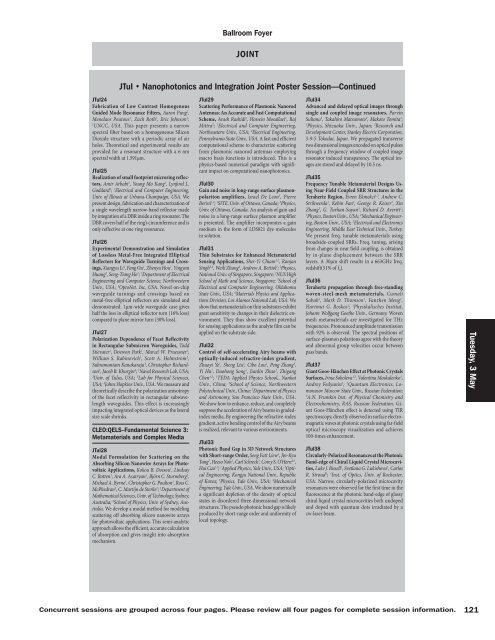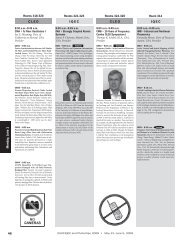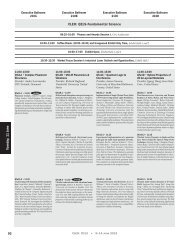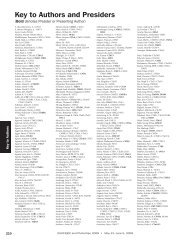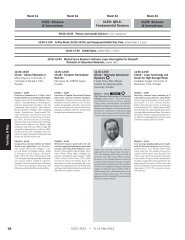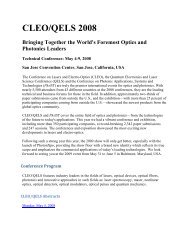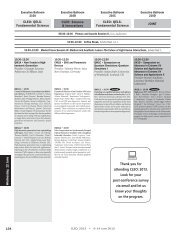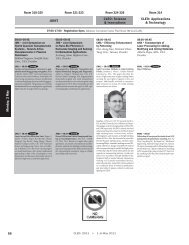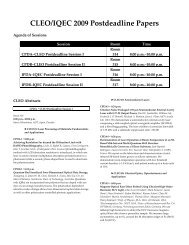Tuesday, 3 May 2011 - CLEO
Tuesday, 3 May 2011 - CLEO
Tuesday, 3 May 2011 - CLEO
Create successful ePaper yourself
Turn your PDF publications into a flip-book with our unique Google optimized e-Paper software.
Ballroom Foyer<br />
JOINT<br />
JTuI • Nanophotonics and Integration Joint Poster Session—Continued<br />
JTuI24<br />
Fabrication of Low Contrast Homogenous<br />
Guided Mode Resonance Filters, Aaron Pung 1 ,<br />
Menelaos Poutous 1 , Zach Roth 1 , Eric Johnson 1 ;<br />
1<br />
UNCC, USA. This paper presents a narrow<br />
spectral filter based on a homogeneous Silicon<br />
Dioxide structure with a periodic array of air<br />
holes. Theoretical and experimental results are<br />
provided for a resonant structure with a 6 nm<br />
spectral width at 1.591μm.<br />
JTuI25<br />
Realization of small footprint microring reflectors,<br />
Amir Arbabi 1 , Young Mo Kang 1 , Lynford L.<br />
Goddard 1 ; 1 Electrical and Computer Engineering,<br />
Univ. of Illinois at Urbana-Champaign, USA. We<br />
present design, fabrication and characterization of<br />
a single wavelength narrow-band reflector made<br />
by integration of a DBR inside a ring resonator. The<br />
DBR covers half of the ring’s circumference and is<br />
only reflective at one ring resonance.<br />
JTuI26<br />
Experimental Demonstration and Simulation<br />
of Lossless Metal-Free Integrated Elliptical<br />
Reflectors for Waveguide Turnings and Crossings,<br />
Xiangyu Li 1 , Fang Ou 1 , Zhenyu Hou 1 , Yingyan<br />
Huang 2 , Seng-Tiong Ho 1 ; 1 Department of Electrical<br />
Engineering and Computer Science, Northwestern<br />
Univ., USA; 2 OptoNet. Inc, USA. Novel on-chip<br />
waveguide turnings and crossings based on<br />
metal-free elliptical reflectors are simulated and<br />
demonstrated. 1µm-wide waveguide case gives<br />
half the loss in elliptical reflector turn (16% loss)<br />
compared to plane mirror turn (30% loss).<br />
JTuI27<br />
Polarization Dependence of Facet Reflectivity<br />
in Rectangular Submicron Waveguides, Todd<br />
Stievater 1 , Doewon Park 1 , Marcel W. Pruessner 1 ,<br />
William S. Rabinovich 1 , Scott A. Holmstrom 2 ,<br />
Subramaniam Kanakaraju 3 , Christopher Richardson<br />
3 , Jacob B. Khurgin 4 ; 1 Naval Research Lab, USA;<br />
2<br />
Univ. of Tulsa, USA; 3 Lab for Physical Sciences,<br />
USA; 4 Johns Hopkins Univ., USA. We measure and<br />
theoretically describe the polarization anisotropy<br />
of the facet reflectivity in rectangular subwavelength<br />
waveguides. This effect is increasingly<br />
impacting integrated optical devices as the lateral<br />
size scale shrinks.<br />
<strong>CLEO</strong>:QELS–Fundamental Science 3:<br />
Metamaterials and Complex Media<br />
JTuI28<br />
Modal Formulation for Scattering on the<br />
Absorbing Silicon Nanowire Arrays for Photovoltaic<br />
Applications, Kokou B. Dossou 1 , Lindsay<br />
C. Botten 1 , Ara A. Asatryan 1 , Björn C. Sturmberg 2 ,<br />
Michael A. Byrne 1 , Christopher G. Poulton 1 , Ross C.<br />
McPhedran 2 , C. Martijn de Sterke 2 ; 1 Department of<br />
Mathematical Sciences, Univ. of Technology, Sydney,<br />
Australia; 2 School of Physics, Univ. of Sydney, Australia.<br />
We develop a modal method for modeling<br />
scattering off absorbing silicon nanowire arrays<br />
for photovoltaic applications. This semi-analytic<br />
approach allows the efficient, accurate calculation<br />
of absorption and gives insight into absorption<br />
mechanism.<br />
JTuI29<br />
Scattering Performance of Plasmonic Nanorod<br />
Antennas: An Accurate and Fast Computational<br />
Scheme, Arash Rashidi 1 , Hossein Mosallaei 1 , Raj<br />
Mittra 2 ; 1 Electrical and Computer Engineering,<br />
Northeastern Univ., USA; 2 Electrical Engineering,<br />
Pennsylvania State Univ., USA. A fast and efficient<br />
computational scheme to characterize scattering<br />
from plasmonic nanorod antennas employing<br />
macro basis functions is introduced. This is a<br />
physics-based numerical paradigm with significant<br />
impact on computational nanophotonics.<br />
JTuI30<br />
Gain and noise in long-range surface plasmonpolariton<br />
amplifiers, Israel De Leon 1 , Pierre<br />
Berini 1,2 ; 1 SITE, Univ. of Ottawa, Canada; 2 Physics,<br />
Univ. of Ottawa, Canada. An analysis of gain and<br />
noise in a long-range surface plasmon amplifier<br />
is presented. The amplifier incorporates a gain<br />
medium in the form of LDS821 dye molecules<br />
in solution.<br />
JTuI31<br />
Thin Substrates for Enhanced Metamaterial<br />
Sensing Applications, Sher-Yi Chiam 1,2 , Ranjan<br />
Singh 3,4 , Weili Zhang 4 , Andrew A. Bettiol 1 ; 1 Physics,<br />
National Univ. of Singapore, Singapore; 2 NUS High<br />
School of Math and Science, Singapore; 3 School of<br />
Electrical and Computer Engineering, Oklahoma<br />
State Univ., USA; 4 Materials Physics and Applications<br />
Division, Los Alamos National Lab, USA. We<br />
show that metamaterials on thin substrates exhibit<br />
great sensitivity to changes in their dielectric environment.<br />
They thus show excellent potential<br />
for sensing applications as the analyte film can be<br />
applied on the substrate side.<br />
JTuI32<br />
Control of self-accelerating Airy beams with<br />
optically-induced refractive-index gradient,<br />
Zhuoyi Ye 1 , Sheng Liu 2 , Cibo Lou 1 , Peng Zhang 3 ,<br />
Yi Hu 1 , Daohong Song 1 , Jianlin Zhao 2 , Zhigang<br />
Chen 1,3 ; 1 TEDA Applied Physics School,, Nankai<br />
Univ., China; 2 School of Science, Northwestern<br />
Polytechnical Univ., China; 3 Department of Physics<br />
and Astronomy, San Francisco State Univ., USA.<br />
We show how to enhance, reduce, and completely<br />
suppress the acceleration of Airy beams in gradedindex<br />
media. By engineering the refractive-index<br />
gradient, active bending control of the Airy beams<br />
is realized, relevant to various environments.<br />
JTuI33<br />
Photonic Band Gap in 3D Network Structures<br />
with Short-range Order, Seng Fatt Liew 1 , Jin-Kyu<br />
Yang 2 , Heeso Noh 1 , Carl Schreck 3 , Corey S. O’Hern 4,3 ,<br />
Hui Cao 1,3 ; 1 Applied Physics, Yale Univ., USA; 2 Optical<br />
Engineering, Kongju National Univ., Republic<br />
of Korea; 3 Physics, Yale Univ., USA; 4 Mechanical<br />
Engineering, Yale Univ., USA. We show numerically<br />
a significant depletion of the density of optical<br />
states in disordered three-dimensional network<br />
structures. The pseudo photonic band gap is likely<br />
produced by short-range order and uniformity of<br />
local topology.<br />
JTuI34<br />
Advanced and delayed optical images through<br />
single and coupled image resonators, Parvin<br />
Sultana 1 , Takahiro Matsumoto 2 , Makoto Tomita 1 ;<br />
1<br />
Physics, Shizuoka Univ., Japan; 2 Research and<br />
Development Center, Stanley Electric Corporation,<br />
5-9-5 Tokodai, Japan. We propagated transverse<br />
two dimensional images encoded on optical pulses<br />
through a frequency window of coupled image<br />
resonator induced transparency. The optical images<br />
are stored and delayed by 10.5 ns.<br />
JTuI35<br />
Frequency Tunable Metamaterial Designs Using<br />
Near-Field Coupled SRR Structures in the<br />
Terahertz Region, Evren Ekmekci 1,3 , Andrew C.<br />
Strikwerda 1 , Kebin Fan 2 , George R. Keiser 1 , Xin<br />
Zhang 2 , G. Turhan-Sayan 3 , Richard D. Averitt 1 ;<br />
1<br />
Physics, Boston Univ., USA; 2 Mechanical Engineering,<br />
Boston Univ., USA; 3 Electrical and Electronics<br />
Engineering, Middle East Technical Univ., Turkey.<br />
We present freq. tunable metamaterials using<br />
broadside-coupled SRRs. Freq. tuning, arising<br />
from changes in near field coupling, is obtained<br />
by in-plane displacement between the SRR<br />
layers. A 30μm shift results in a 663GHz freq.<br />
redshift(51% of f 0 ).<br />
JTuI36<br />
Terahertz propagation through free-standing<br />
woven-steel-mesh metamaterials, Cumali<br />
Sabah 1 , Mark D. Thomson 1 , Fanzhen Meng 1 ,<br />
Hartmut G. Roskos 1 ; 1 Physikalisches Institut,<br />
Johann Wolfgang Goethe Univ., Germany. Woven<br />
mesh metamaterials are investigated for THz<br />
frequencies. Pronounced amplitude transmission<br />
with 92% is observed. The spectral positions of<br />
surface-plasmon polaritons agree with the theory<br />
and abnormal group velocities occur between<br />
pass bands.<br />
JTuI37<br />
Giant Goos-Hänchen Effect at Photonic Crystals<br />
Surfaces, Irina Soboleva 1,2 , Valentina Moskalenko 1 ,<br />
Andrey Fedyanin 1 ; 1 Quantum Electronics, Lomonosov<br />
Moscow State Univ., Russian Federation;<br />
2<br />
A.N. Frumkin Inst. of Physical Chemistry and<br />
Electrochemistry, RAS, Russian Federation. Giant<br />
Goos-Hänchen effect is detected using TIR<br />
spectroscopy, directly observed in surface electromagnetic<br />
waves at photonic crystals using far-field<br />
optical microscopy visualization and achieves<br />
100-times enhancement.<br />
JTuI38<br />
Circularly-Polarized Resonances at the Photonic<br />
Band-edge of Chiral Liquid Crystal Microcavities,<br />
Luke J. Bissell 1 , Svetlana G. Lukishova 1 , Carlos<br />
R. Stroud 1 ; 1 Inst. of Optics, Univ. of Rochester,<br />
USA. Narrow, circularly-polarized microcavity<br />
resonances were observed for the first time in the<br />
fluorescence at the photonic band-edge of glassy<br />
chiral liquid crystal microcavities both undoped<br />
and doped with quantum dots irradiated by a<br />
cw-laser beam.<br />
<strong>Tuesday</strong>, 3 <strong>May</strong><br />
Concurrent sessions are grouped across four pages. Please review all four pages for complete session information.<br />
121


